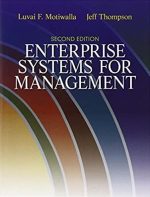Enterprise Systems for Management 2nd Edition by Luvai Motiwalla, ISBN-13: 978-0132145763
[PDF eBook eTextbook]
- Publisher: Pearson; 2nd edition (August 6, 2019)
- Language: English
- 384 pages
- ISBN-10: 0132145766
- ISBN-13: 978-0132145763
Enterprise systems include enterprise resource planning (ERP), supply chain management (SCM), customer resource management (CRM), and other enterprise-level systems that are critical to all dynamic, globally aware companies. ERP systems are important factors in the success of corporations today. With a diversified global market, technology is utilized to overcome distance, language, and culture. Today’s information systems have permeated well beyond the traditional functional applications, and even the more technologically current client–server applications, to mission-focused enterprise systems.
This second edition of the book describes the components of an ERP system and provides an introduction to the process of implementing a successful system in today’s organizations. Because ERP systems are complex, they often require a large investment of money and time. An ERP implementation impacts a large number of people, both inside and outside the organization. It also requires both carefully crafted business needs and a comprehensive change management strategy. Enterprise systems extend from the back-end supply chain operations to front-end customer-facing services that extend beyond the boundaries of the enterprise. As such, the implementation process is increasingly expensive, intense, and prone to failure than were traditional information system implementations.
Organizations considering an investment in enterprise systems should be educated on enterprise systems components and architecture, as well as both their short- and long-term impacts on the organizational business processes. Management needs to be prepared to address the technology issues of enterprise systems and, more importantly, the business processes, corporate policies, change management, and people expectations. The goal of this book is to educate students on these issues and on the value that enterprise systems add to today’s companies. Students will learn how enterprise systems can remove structural and functional barriers to make organizations more cross-functional and productive. Students will also learn about the enterprise system’s technology and implementation life cycle and develop an understanding of the impact on processes and people in an organization. This book places major importance on the strategic role of ERP systems in providing a platform for improved business operations and productivity.
In addition, the book emphasizes both business and managerial aspects of enterprise systems from planning to postimplementation. This edition specifically
– provides several examples of real-world company issues that occurred while implementing enterprise systems;
– provides a step-by-step learning process for students, using organized materials, and learning about enterprise system implementations;
– focuses on a pedagogy that lays out concise learning goals and reinforces the concepts learned using cases, discussion questions, and exercises; and
– highlights issues within the implementation process that have implications for management.
Table of Contents:
Chapter 1: Introduction to Enterprise Systems for Management
Chapter 2: Systems Integration
Chapter 3: Enterprise Systems Architecture
Chapter 4: Development Life Cycle
Chapter 5: Implementation Strategies
Chapter 6: Software and Vendor Selection
Chapter 7: Operations and Post-implementation
Chapter 8: Program and Project Management
Chapter 9: Organizational Change and Business Process Reengineering
Chapter 10: Global, Ethics, and Security Management
Chapter 11: Supply Chain Management
Chapter 12: Customer Relationship Management
What makes us different?
• Instant Download
• Always Competitive Pricing
• 100% Privacy
• FREE Sample Available
• 24-7 LIVE Customer Support









Reviews
There are no reviews yet.